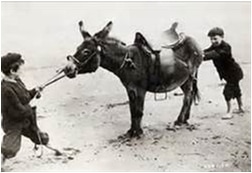When working with a horse in a therapy session push and pull equate to assertive and passive. When horses communicate, it is through pushing. Boundaries are demonstrated through pushes in body language. A horse can push another away with an assertive look or swing a rear end around in a gesture to kick. Getting needs met is demonstrated by moving near and leaning toward or pushing into.
Horses don’t pull at each other. The closest thing to a pull to a horse is one calling out to another vocally. So what is the push about and what does that have to do with a therapeutic encounter?
During a therapeutic equine session a Participant often needs to move the horse in order to accomplish the task. Given that there is no halter or rope available this can present a challenge. More than 90% of the time the Participant tries “pulling” the horse by:
- Calling to it. “Come on Henry! Come here!”
- Trying to verbally convince it. “You’re a good boy. You know you want to come!”
- Turn their back in hopes the horse will respond to the “hard to get” approach
- Walk away in hopes he will follow.
This type of “pulling” is coercive, indirect and passive.
All of these things are done in front of the horse. There is no pressure/push for the horse to respond to. It’s a passive way, a least invasive attempt to convince or appeal enough to the animal that it may want to move toward them.
How often to do we pull when direct communication would be so much more effective?
Other than literally pulling with a rope, a horse does not register a pull as pressure. It is just something occurring in the space at the moment that has no direct affect on its current state of being. Looking at how they communicate gives us a clue to healthy communication. The push is a natural pressure toward. It communicates intent in an assertive clear way. Participants push a horse by:
- Walking up with energy and intention
- Using their voice and body to create pressure
- Holding a confident assertive mind set
- Making contact with the horses boundaries
A push does not occur directly in front of the horse. It happens from the shoulders back. The most obvious difference is the feeling associated with a push. Although initially uncertainty is common, practicing it causes an internal shift. Moving with strength and intention creates energy. This is energy and pressure that the horse can clearly feel and will respond to. The horse now understands what you are saying and can move accordingly.
Learning how to push a horse changes the way Participants ask for needs and wants. It is a tangible way to experience healthy communication in a safe place.

